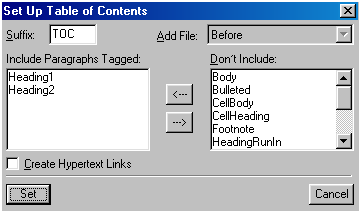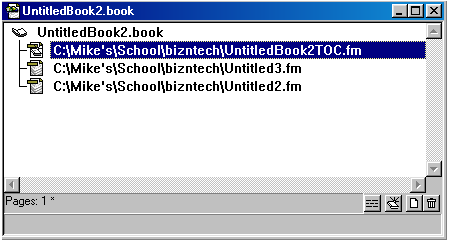Adobe FrameMaker Tutorial – Table of Contents
Before You Start
Make sure you’ve assigned paragraph tags to every paragraph in your document. This is absolutely necessary before generating a table of contents, as the entries in the TOC will come from whatever tags you assign.
You’re going to be generating a Table of Contents for the document you’ve created. Rather than going through and finding page numbers, heading titles, etc. yourself, FrameMaker does it all for you.
Generating the TOC – Working With One File
Go up to the “File” menu, and select “Generate/Book” (in version 6.0, select “Table of Contents” from the “Special” menu). In the box that appears, select “Table of Contents” in the “List” box, since that is what we will be working with. Click “Generate.” In the new window that appears, you’re going to select which tags you want to be listed in the TOC. For example, if you headed a section of a computer book “Websites” and want to make “Websites” one of the “chapters” in the TOC, the tag associated with “Websites” is something you’d pick. For the most part, “Heading1” is what most people associate with their headings, so you will probably want to do the same. If there are any others you want to use, you may do so.
 |
Use the appropriate arrows to move headings to the left (or back to the right if you do not want them). Once this is done, you may click “Generate” once more. A new FrameMaker document will open, listing the headings you told it to, along with their respective page numbers. From here, you can edit this page in any way you choose. Be sure to save this file.
Generating the TOC – Working With Multiple Files
Go up to the “File” menu, and select “Generate/Book.” In the box that appears, select “New Multifile Book, Including [documentname],” where [documentname] is whatever filename you have given the currently open file. You are choosing this because you are working with multiple FrameMaker documents, which in the end, will all form one large publication. The “Book” window will now open, and include that file in it. You need to add the rest of your FrameMaker files to this book before generating the TOC. Go to the “File” menu (with the book file still open) and select “Add File.” In this new window, select “Document File,” since that is what we are adding. Use the “Browse” button to find the next file you will be adding. In the next pull-down menu, you can choose to add the file before or after the file currently in the book. This is necessary for keeping your publication in order. Choose the correct option for your book, and click the “Add” button. Repeat this as necessary until all appropriate files have been added. Click “Done” when this is complete.
 |
In the “Book” window, if need be, you can still rearrange the order of files. Simply right-click the file you wish to move, and select either “Move Up” or “Move Down.” Go up to the “File” menu, and select “Generate/Book.” In the box that appears, select “Table of Contents” in the “List” box. In the new window that appears, you’re going to select which tags you want to be listed in the TOC. For example, if you headed a section of a computer book “Websites” and want to make “Websites” one of the “chapters” in the TOC, the tag associated with “Websites” is something you’d pick. For the most part, “Heading1” is what most people associate with their headings, so you will probably want to do the same. If there are any others you want to use, you may do so. Use the appropriate arrows to move headings to the left (or back to the right if you do not want them). Once this is done, click “Set.” You will see that a file ending with “TOC.fm+” has been added to the list of documents. Click “Done” in this window, and you will have added the TOC to your book. At this point, be sure to move the TOC to the top of your book file, since table of contents always begin a book.
Go up to the “File” menu, and select “Save As” to save this book file.
Once this is done, go up to the “File” menu once more, and select “Generate/Update” again (all while the book window is still open and the window of focus). Your book file should be in the left column. Click “Update,” and your TOC should be generated. If it does not open automatically, double click its name in the book file. A new FrameMaker document will open, listing the headings you told it to, along with their respective page numbers. From here, you can edit and format this page in any way you choose.
 |


Comments